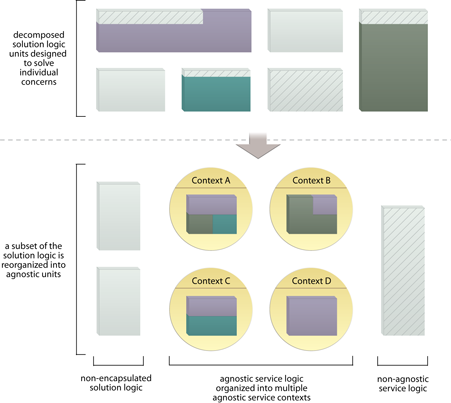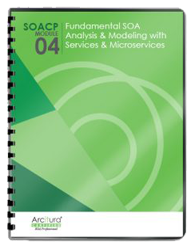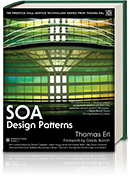SOA Patterns > Foundational Service Patterns > Agnostic Context
Agnostic Context (Erl)
How can multipurpose service logic be positioned as an effective enterprise resource?

Problem
Multi-purpose logic grouped together with single purpose logic results in programs with little or no reuse potential that introduce waste and redundancy into an enterprise.
Solution
Isolate logic that is not specific to one purpose into separate services with distinct agnostic contexts.
Application
Agnostic service contexts are defined by carrying out service oriented analysis and service modeling processes.
Impacts
This pattern positions reusable solution logic at an enterprise level, potentially bringing with it increased design complexity and enterprise governance issues.
Principles
Architecture
Service
 The application of this pattern results in a subset of the solution logic being further decomposed and then distributed into services with specific agnostic contexts.
The application of this pattern results in a subset of the solution logic being further decomposed and then distributed into services with specific agnostic contexts.
Related Patterns in This Catalog
Agnostic Capability, Agnostic Sub-Controller, Canonical Expression, Capability Recomposition, Composition Autonomy, Cross-Domain Utility Layer, Entity Abstraction, Logic Centralization, Service Encapsulation, Utility Abstraction
Related Service-Oriented Computing Goals
Increased Business and Technology Alignment, Increased Organizational Agility, Increased ROI, Reduced IT Burden
This pattern is covered in SOACP Module 4: Fundamental SOA Analysis & Modeling with Services & Microservices.
For more information regarding the SOA Certified Pofessional (SOACP) curriculum,
visit www.arcitura.com/soa.
This page contains excerpts from:
SOA Design Patterns by Thomas Erl
(ISBN: 0136135161, Hardcover, Full-Color, 400+ Illustrations, 865 pages)
For more information about this book, visit www.arcitura.com/books.

